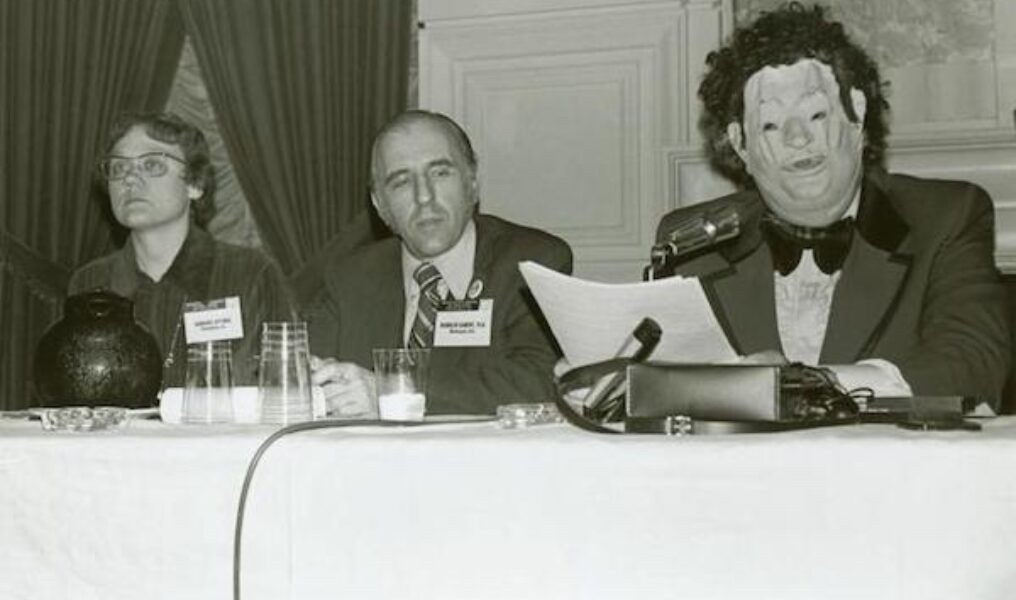For decades, the American Psychological Association (APA) labeled homosexuality a mental illness, thereby justifying the criminalization of homosexuality and permitting discriminatory practices against gay men and lesbians by government agencies, businesses, schools and churches repulsed by those branded "sick" and "perverted."
But homosexuality was also believed to be a deviant behavioral choice that could be "cured" through medical and psychological treatments such as electroshock, chemical castration, ice pick lobotomies or aversion "therapy" akin to the torture in "A Clockwork Orange."
Not all mental health professionals thought gay people were degenerates. In 1953, with Republican Sen. Joe McCarthy in his prime demagogically chasing down and destroying communists (the "Red Scare") and homosexuals (the "Lavender Scare"), Evelyn Hooker, Ph.D., sought funding from the National Institute of Mental Health to research "normal homosexuals," prompted by her close friendship with a former UCLA student, Sam From. Through him, she gained access to LA's secret gay subculture and volunteers from the Mattachine Society. Hooker's presentation at the APA's annual convention in 1956 was groundbreaking— there was no scientific data on gay people who were not incarcerated or in mental wards. The bottom line result: expert clinicians could not distinguish between gay men and straight men, findings that were soon validated by other researchers.
But the APA did not remove homosexuality from its Diagnostic and Statistical Manual III (DSM) until 1973. "Cured," an in-production documentary directed by award-winning filmmakers Patrick Sammon and Bennett Singer, details the story of how LGBT activists joined forces with other minority groups and allies to take on the psychiatric establishment in the late 1960s and early 1970s to change the DSM.
As befitted the time of upheaval with students protesting the war in Vietnam and civil rights groups morphing into liberation movements, the fights against the APA were not quiet. One of the first demonstrations was staged in San Francisco by 20 members of the Gay Liberation Front and Women's Liberation Movements. "It put the psychiatrists on notice," Sammon said, "that gays and lesbians were fighting back. It really was the start of the outside activism that put attention and pressure on this issue."
From California, protests spread to other cities, like Chicago and New York. "The interesting thing about this is there was no coordinated strategy, in terms of one person deciding what would happen. It was a grassroots effort," Sammon. "That was an important piece of the equation that we discovered during the research process."
But there were pioneering leaders with vision from Barbara Gittings of the New York chapter of the Daughters of Bilitis, Frank Kameny, co-founder with Jack Nichols of the Washington, D.C. branch of the Mattachine Society, and Morris Kight and Don Kilhefner, co-founders of the Gay Liberation Front/LA, who disrupted APA conferences by stealing the emcee's microphones and challenging the participants. In 1972, gay psychiatrist Dr. John Fryer had enough and spoke out—albeit with his face disguised in a mask and voice distorted over the microphone. Nonetheless, "Dr. Henry Anonymous," as he presented himself, gave such as impactful speech, history has often credited him with getting homosexuality de- listed from the DSM in 1973.
Sammon believes that much of the progress in the struggle for LGBT rights—for social, legal, and political equality—was made possible by this victory in 1973 over the APA. While still largely overlooked in LGBT history, the campaign challenging the APA represents a remarkable story of diligence and courage in the face of powerful institutional resistance.
Singer also notes that "Cured" looks at how the modern LGBT rights movement continued after Stonewall. "How did the spark that was ignited at Stonewall and other uprisings around the country get channeled? What was the next stage of activism?"
Sammon hopes older LGBT audiences will see an accurate reflection of their lived experiences, of the pain caused by the message from scientific and medical institutions that they were sick. "If from the age of 12 or 13," he told the Los Angeles Blade in a June 19 interview, "everything you read or everything you're told is that you're mentally ill, that starts to impact you. That starts to affect your self-esteem. It causes internalized homophobia."
In the years since, leading organizations representing scientists and physicians have uniformly denounced treatments intended to change a patient's sexual orientation or gender identity. More recent progress on this front includes the decision by the World Health Organization to remove gender incongruence from the mental disorders listed in its International Classification of Diseases (ICD), the eleventh revision of which was released June 18.
However, despite this, disproven pseudo-scientific ideas about the mental health of LGBT people are still used to support so- called "conversion" or "reparative therapy," religious-based counseling and other harmful sexual orientation change efforts (SOCE).
The campaign against the label of mental illness chronicled in "Cured" is not "a relic from history," Singer said. "People are still clinging to this junk science that's being held up to give LGBTQ people this bogus sense that they can change, that they should change, and that homosexuality is a choice."
Sammon agreed: "The roots of this mental illness label are ideas that are still parroted by people who believe in conversion therapy," he said. "Hopefully, this film—while not specifically about that issue [of conversion therapy]—can help illuminate that ongoing discussion, while weakening this argument that LGBT people have chosen to be the way that they are."
"There's still a learning curve when it comes to these fundamental issues," Singer said. "We're seeing it with the attempt to roll back the Pentagon's policy on trans service members, with ongoing opposition to marriage, with bathroom bills…many of these positions come from prejudice based on junk science and religious belief."
"Cured" is a warning that the fight for equality is ongoing—that progress can be ephemeral. It is also an homage to the activists who sacrificed much but recognized the importance of the fight.
"I hope older audiences, through the film, will receive some appreciation for the work they did to get us to the point where we are now," Sammon said. "There are so many people who helped in so many ways, and this is a way to honor them."
Charles Francis, president of the Mattachine Society of Washington, D.C., told the LA Blade that they decided to sign on as financial sponsors of "Cured" because the film debunks the myth that the LGBT community has won the battle against those who wish to call them mentally ill.
"It's a myth," Francis said, "because not only was it hell to accomplish this thing [striking homosexuality from the DSM], with real community activism, but even today the debate is not over. Our enemies are making the case they we are somehow spiritually or psychologically broken, even now in 2018." At the Mattachine Society, Francis is engaged in historical research about the institutionalization of LGBT people in places like St. Elizabeth's hospital in Washington, DC where the APA's mental illness label and legislation like the District's Sexual Psychopath Act of 1948, resulted in people being subjected to "treatments" that included icepick lobotomies, hysterectomies, and castration.
Even today, Francis warned, mythical ideas about LGBT mental illness have lead to young LGBTQ people being put in harm's way. Among the most troubling recent examples are reports of young people who have died as a result of abuse incurred at residential programs associated with the billion dollar "troubled teen industry"—a sexual orientation change efforts into which youth are sometimes enrolled by their parents.
"This movie is not just for gay history geeks," Francis said. "I think all activists, all audiences, all people concerned with the Trump-Pence Administration would do well to see this movie and to see how old school community activism works. Getting out into the streets, into the communities, convincing people, making the arguments… this is an early example of passionate, community-based activism. I think it's a movie for everybody, especially in these challenging times."
After its 1973 decision, the APA came out against discrimination based on sexual orientation in employment (1988) and in the armed forces (1990). Then, in 1998, the organization issued statements that opposed psychiatric treatments that (1) are based on the view of homosexuality as a mental disorder, and (2) are administered to "change" the patient's sexual orientation.
The mainstream medical establishment is now allied with efforts to protect young LGBT people from conversion therapy, which marks a significant step forward. Interestingly, science and medicine have recently been harnessed to oppose these practices from a different angle.
A bill spearheaded by Equality California and introduced by out Assembly member Evan Low would include, among the business practices outlawed under California's Consumer Legal Remedies Act, the sale of therapies that constitute sexual orientation change efforts because research indicates they are ineffective.
"The bill does one thing and one thing only;" said Low, in a press release, "it declares conversion therapy (for money) for what is, a fraudulent practice.
The directors hope to release "Cured" in 2019— the 50th anniversary of the Stonewall Riots.
This article originally appeared in the Los Angeles Blade and is made available in partnership with the National Gay Media Association.










